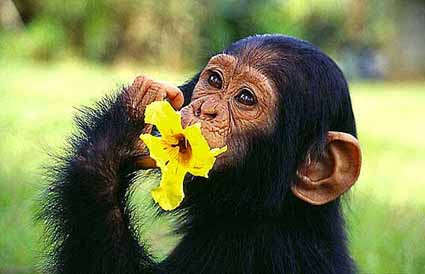'Drunk and Disorderly' Chimps
Attacking Ugandan Children
By WAIRAGALA WAKABIChimpanzees in western Uganda are increasingly raiding illegal brewing operations in forested river valleys and getting drunk on the country beer. Once intoxicated, they become hostile and attack and at times kill human children, parks officials say.
The officials, however, insist that even a drunk chimp cannot take on a grown man. All the babies they have attacked have been either unaccompanied, or are in in the company of other children.
One notorious chimp nicknamed Saddam is blamed for killing at least three babies and maiming several others in Ruteete sub-county which borders the Kibale National Park.
Early this year, officials of the Jane Goodall Institute in Uganda were quoted in BBC's Wildlife Magazine as saying that chimpanzees had killed eight children and injured many others in Ugandan national parks. Debby Cox, the director of the institute, suggested that the aggressive behaviour of the chimps was caused by increased proximity between the animals and humans.
Dr Michael Gavin, who carried out the study, was reported by the magazine as saying that the technique used by the chimps to kill or maim the children mirrored the way they tear apart other prey, suggesting that they snatched the children to eat them. "In most cases they bite off the limbs first before disembowelling them, just as they would the red colombus monkey, which is among their favourite prey," he said.
A January 14 report on the chimp attacks, prepared by the Uganda Wildlife Authority (UWA), says that local beer is usually brewed illegally along river valleys, which are also the habitat of chimps. "When chimps come across the local brew, they drink it, become drunk and in that state any encounter with people means an attack," says the report, compiled for the UWA executive director, a copy of which was obtained by The EastAfrican.
In the Kibale Park, situated in an area known for brewing banana beer, authorities say there have been 12 chimp attacks since 1996, and three of the victims died. The park recorded at least six other attacks between 1992 and 1995.
The attacks are normally experienced in areas neighbouring the park and normally occur between October and December. This is probably due to food scarcity prevailing in the main chimp habitat during this period, which forces them to move beyond the park boundary in search of food.
"Crops such as sugarcane and bananas, which are grown near the parks, are preferred by chimps. Once the chimps come across a sugarcane plantation, for example, they tend to abandon the park and, as a result, come into conflict with the local communities," says the report.
And when crop-raiding chimps are chased, they get frightened and charge back – especially if they have imbibed some brew.
Barbara Musoke, spokesperson of the Uganda Wildlife Authority (UWA), said that the killings had taken place over a period of 10 years. "We have reduced wildlife and human conflicts. The cases reported are cumulative, they happened over a period of time," she said, adding that the incidence of attacks had dropped.
Ms Musoke also said that, in the past one year, there had been no chimp attacks at all. Most of the attacks reportedly took place on the outskirts of the game parks and others in parts of the parks where people cultivate and sometimes settle illegally. Local villagers also go into the parks in search of fuelwood, fruit and poles for building houses.
"We educate the public on wildlife and its behaviour and we have buffer zones between human settlements and the parks. In areas frequented by elephants and buffalo, we have built trenches to stop these animals from crossing the boundaries," Ms Musoke said. The authority also has wildlife reserve management committees where local communities are represented, making it easier to educate the public on living harmoniously with the wildlife.
The most recent chimp attacks resulted in the death of a three-month-old child while two others were maimed. The dead child, was snatched by a chimp from under a tree in a vegetable garden where his mother and grandmother were digging. The child was rescued by people in the neighbourhood, but the chimp had torn off his face and he died in hospital.
UWA says that all the attacks involved children under five years old and took place when no men were around. In some cases, children left unguarded cried, attracting the attention of chimpanzees. The victims were usually carried between 13 and 240 metres from the scene of the attack. "The attacks were predatory in nature," said a UWA official, "because the chimpanzees attempted to carry the child away and eat it."
Following the recent attacks, local people have reportedly become increasingly vigilant, abandoning remote fields near forest patches and never leaving young children unattended. UWA has also dug moats around parks and other protected areas, and widened the buffer zones between humans and wildlife.
The UWA report says that, prior to the events in Kibale, there had been only one published account of a chimpanzee attacking and killing a human child. The incident occurred in Tanzania when a group of women gathering firewood met an adult male chimpanzee. It seized a baby from its mother's back and partially ate it. The earliest cases in Uganda were reported in 1992, when two children were killed in Kibale.
Conservationists say that because reports of chimp attacks are rare, they are difficult to interpret. "The behaviour of a normal chimpanzee is well known. Ordinarily, chimpanzees live as a large social community (20-120 individuals), travel over a wide area, are afraid of people and tend to make predatory attacks – at least on monkeys – when in a large group. By contrast, the attacks documented in Uganda were by solitary chimpanzees, except for one incident in which two chimps were involved."
Ugandan wildlife officials say cases of chimpanzee attacks on humans, particularly children, have been minimised in recent years after extensive buffer zones were created between wildlife reserves and human settlements. Increased human encroachment on game sanctuaries, usually accompanied by large-scale deforestation, had seen a rise in chimpanzee attacks on humans, resulting in some deaths.
UWA officials say the research was carried out in good faith and will give "a better sense of direction on how to handle conflicts between wildlife and humans." They did not expect locals to hunt down the chimps because "they are aware of the importance of chimps and those attacks are just isolated incidents," said Ms Musoke.
Ignatius Nyakisero, marketing manager of the Uganda Tourist Board, said a team would be sent to the game reserves to establish whether there were still cases of chimps attacking humans. There were fears that the tourism industry would suffer unless the government clarified that the attacks had abated and the reported deaths took place over a period of 10 years.
Uganda is heavily reliant on the tourism industry, which is the leading foreign exchange earner. In 2002, the country attracted 254,000 tourists and this figure is expected to have risen by about 15 per cent in 2003. The country seeks to attract 500,000 tourists annually by 2014.
Researchers from the Goodall Institute earlier this year found that Uganda has 4,950 chimpanzees. This figure was earlier estimated at 3,000-4,000.
In Uganda, out of the 20 forests surveyed, only four were found to have chimp populations that were large enough to remain viable in the long run. The researchers also reported that over 25 per cent of chimpanzees in tourist and research areas had missing hands or feet as a result of snares set for antelopes.
Tony Kirungi, a conservation official with the Queen Elizabeth National Park, says communities neighbouring Ugandan parks continue to experience crop raids and animal attacks on humans.
Elephants, velvet monkeys, bush pigs and baboons are the other major problem animals for the local communities. Besides moats, park officials are also planting thorny shrubs and constructing stone walls around the parks.
President Museveni has suggested that electric fences be erected around the parks to rein in the wild animals.
Chimps and gorillas are among the top tourist attractions in Uganda, accounting for over half of UWA's income. But UWA officials say gorillas are by far the most popular and that, unlike chimps, gorillas do not attack humans.
Uganda has about 350 mountain gorillas, out of a total of only 600 in the entire world. The rest of the gorillas are said to be in Rwanda and the Democratic Republic of Congo, both Uganda's neighbours.
Mountain gorillas feature prominently in a TV documentary just released by Discovery Channel on Uganda, in which President Museveni guides the camera in the western Bwindi and Mgahinga national parks.
HOME
Primate Info
Animal Medicine
Primate Species
Animal Rights FAQ
Chimpanzee Genome
Chimpanzee Hotlinks
Retired Chimpanzees
Self-medicating lemurs
Chimpanzee Fact Sheet
Monkey Sense of Justice
Chimpanzees: First Contact
The chimpanzee genome decoded
Facial Expressions as Guide to Speech
Young Female Chimps Outsmart Their Brothers

